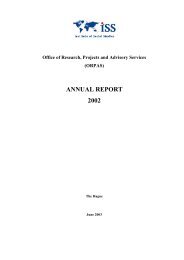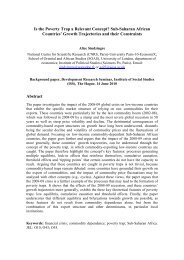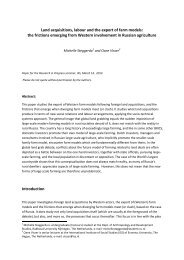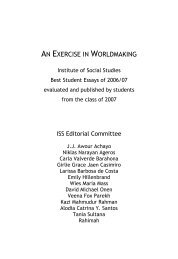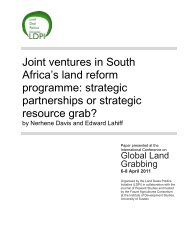AN EXERCISE IN WORLDMAKING 2009 - ISS
AN EXERCISE IN WORLDMAKING 2009 - ISS
AN EXERCISE IN WORLDMAKING 2009 - ISS
Create successful ePaper yourself
Turn your PDF publications into a flip-book with our unique Google optimized e-Paper software.
122 ISABELLE TURCOTTE<br />
ity enhancement. The success of these services suggests a transition into<br />
formal jobs, or the ability to independently produce goods and services<br />
by means of their own formal enterprises. This has in turn incited other<br />
macro-policies on behalf of central government, notably the National<br />
Plan for the Development of Micro-enterprises which regroups three<br />
micro-enterprise typologies including ‘growth,’ ‘survivalist’ and ‘associative’<br />
micro-enterprises.<br />
With the legacy and continued presence of the gremios (business associations),<br />
micro-enterprises are encouraged to join panels and participate<br />
in forums related to their trade. Workers and business owners are<br />
encouraged to integrate in these organizations that “offer collective solutions<br />
to common problems” such as employment protection and stability,<br />
and representativeness in the face of government of private institutions<br />
(Alves et al. 1998: 32). These gremios are practical platforms of<br />
negotiation resembling unions, yet breaking the traditional employer/<br />
employee relationship, replacing it with a sectoral focus and a diversity of<br />
legal statuses, allowing smaller informal micro-enterprises to formalize<br />
relationships. These networks expand the bargaining power of individual<br />
micro-enterprises and include them within an intricate system of relationships<br />
that reduces, at least in theory, the structures of disadvantage<br />
inherent to the atomized state of unorganized informal work.<br />
CONCLUSIONS ON EVOLV<strong>IN</strong>G DISCOURSE <strong>AN</strong>D PRACTICE<br />
The Statistics Bureau of Colombia known as the D<strong>AN</strong>E holds updated<br />
data regarding the informal sector based on the current ILO definition as<br />
a basis of measuring informality, yet it includes all enterprises in which<br />
ten or less employees actively work. While this may simplify measurement,<br />
it demonstrates that micro-enterprises in themselves are the specific<br />
area of focus, as there are many small enterprises that can have perfectly<br />
formal labor relationship and status, and larger enterprises that do<br />
not ensure proper coverage to their employees or avoid taxation. This<br />
goes to confirm that the political focus has shifted to productive capacity<br />
rather than intrinsic rights, obligations and status.<br />
The D<strong>AN</strong>E indicators for informality state that between 2007 and<br />
2008, informal employment still accounts for 55 to 58 percent of total<br />
employment with its value of GDP just above 30 percent (D<strong>AN</strong>E, Boletin<br />
de Prensa: Informalidad 2008). What we learn from such statistics is<br />
that the proportion of small producers has virtually been left unaltered in




